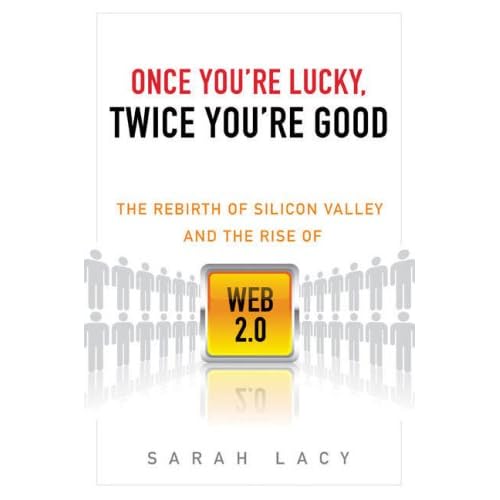Sarah Lacy's upcoming book Once You're Lucky, Twice You're Good: The Rebirth of Silicon Valley and the Rise of Web 2.0 is destined to be the definitive work on this idea.
 When her book hits the shelves in May, it's likely to make a lot of non-Silicon Valley types examine exactly how this technological shift impacts the world around them.
When her book hits the shelves in May, it's likely to make a lot of non-Silicon Valley types examine exactly how this technological shift impacts the world around them.For those of us in PR, the shift has been happening for quite a while. Brian Solis fixed the term PR 2.0 in the lexicon when he began a blog of the same name in April of 2006, and Todd Defren has been monitoring the impact of the new web on the communications industry from his vantage point at Shift Communications for the past several years. Of course there are hundreds of other pundits and commentators as well - far too many to mention here.
The point is, they're all saying the same thing. More and more people have stopped simply receiving information and have begun to actively create it. More and more people now get their information from sources that didn't even exist 5 years ago.
My own information habits have changed drastically over the last few years. My morning hours are now spent absorbing information via blog readers, minute-by-minute updates from both industry leaders and personal friends via Twitter and Facebook, broadcast news delivered via TiVo, and radio news delivered via podcast. At no point do I interact with traditional media in any way. And the same is true for most of my peers.
For the PR industry, this poses a particular problem. Since we're in the business of feeding information into an existing distribution structure, what happens when the structure shifts? The answer: We must shift as well. And fast.
While it used to be sufficient to send a standard press release to a set of wire services - now both the release itself, as well as the distribution mechanism, are in flux.
- Social Media Releases - Not all content creators are journalists. Journalists are trained to tell stories. Bloggers, pundits and analysts are much more interested in tracking industry changes one fact at a time. Traditional press releases are designed to tell the whole story at once. Social media releases just list the facts, key quotes, and critical issues.
- Social Media Optimization (SMO) - Just as search engine optimization (SEO - which I posted about earlier this month) is a critical component of any web strategy, optimizing your publicity efforts so they can be easily spread by supporters using social media sites is now critical as well.










4 comments:
Well said Leyla. You're right. We're all saying the same thing, but there's still much work to do in order to reach the industry as a whole and learn together in the process. It's important to adapt to the evolution of how information is shared and discovered. Not only are the mediums and tools evolving, the new media landscape is also demanding a different take in how PR "speaks" with and approaches people.
Even though I didn't start a blog called PR 2.0 until 06...I started using the PR 2.0 moniker in the late 90s to describe the shift introduced by Web 1.0 would forever change PR, opening up the gates for us to reach people directly outside of the usual channels of influence. DejaNews, Google and Yahoo Groups, and user-generated "enthusiast" sites such as Steve's Digicams were catalysts for the methodology used in today's best practices for blogger relations.
Great post!
Brian - thanks so much for stopping by!
I've admired your work for a long time - but didn't realize that the PR2.0 moniker preceded your blog by so many years. I appreciate the correction.
I look forward to hearing your thoughts on the C+E blog again soon!
Dear Leyla,
First of all let me introduce my self. I'm Irene and I am currently a post-graduate student in the University of Stirling, doing my Masters in Public Relations.
I was reading your brilliant post and your opinion about the emerging need of PR 2.0 replacing the ‘old’ PR methods and practices and I would like to express my opinion as a future PR practitioner.
I believe that the truth lies somewhere in between. Newer communication technologies can — and will — bring higher efficiency to the profession and a unique impact on the way public relations is practiced or theorized. But, PR 2.0 view equates PR with the technology, which is wrong and irrelevant and at the same time implies replacement instead of addition of some new tools and techniques to the existing PR traditional methods. Strong writing skills, creativity and, most of all, individual relationships are important human factors that simply cannot be replaced by the new digital world.
In conclusion, then, it is useful when investigating the diffusion of new technologies into PR nature to consider practitioners’ perception of technology, its use and power. Educating one-self and maintaining thoughtfulness about what should change and why in the contemporary PR practices and theories, maybe be the keys in taking the most of these new tools.
That's my personal opinion, thank you for your space!
Cheers!
Well said Irene - the industry is going to be lucky to have you once you finish school!
Post a Comment